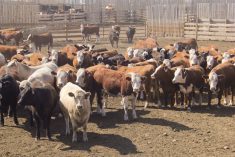Chicago | Reuters — Chicago wheat futures gained on Tuesday as traders eye winter wheat conditions across the U.S. Plains amid a second frigid cold snap this season, though futures struggled against technical resistance.
Soybeans futures ended up, though prices were pressured by a correction in the soymeal charts, traders said. Corn futures ended lower, amid technical selling and end-of-month positioning by investors.
The most-active wheat contract on the Chicago Board of Trade added 8-3/4 cents, to settle at $7.61-1/4 a bushel (all figures US$).
Read Also

U.S. livestock: Feeder cattle hit contract highs on tight supply
Chicago | Reuters – All Chicago Mercantile Exchange feeder cattle futures and most live cattle futures hit contract highs on…
CBOT soybeans climbed 2-3/4 cents, to settle at $15.38 a bushel, while corn fell four cents to $6.79-3/4 a bushel.
Wheat found support as winter wheat crop conditions across the U.S. Plains remained uncertain, improving slightly in Kansas, the top U.S. winter wheat-producing state, during January but fell sharply in Oklahoma, the No. 3 grower, the U.S. Department of Agriculture (USDA) said on Monday.
Wheat futures continue to struggle against technical resistance, said Kristi Van Ahn-Kjeseth, chief operating officer at consulting firm Van Ahn and Company Inc.
“Wheat is at the bottom end of the range. It’s been hit hard,” she added. “We got a rebound off the low, and we’re trying to extend that.”
On Monday, the soybean and corn contracts reached their highest in nearly two weeks while wheat touched a near four-week peak.
Earlier in the trading session, soybeans found support from dry forecasts in exporter Argentina that could continue to erode yields, while delayed soy harvests in Brazil could push back corn planting.
“We might be getting a little bit bigger window of exports from the U.S.,” said Brian Basting, commodity research analyst at Advance Trading.
Traders watched for clues as to Chinese demand following last week’s Lunar New Year holidays.
Macro-economic news capped gains, as investors broadly expect the U.S. Federal Reserve to raise interest rates by 25 basis points on Wednesday, while both the Bank of England and the European Central Bank are seen raising rates on Thursday.
The dollar index rose, making U.S. commodities more expensive to holders of other currencies.
Investors were also making end-of-month adjustments to positions, analysts said.
— Reporting for Reuters by Christopher Walljasper and P.J. Huffstutter in Chicago; additional reporting by Gus Trompiz in Paris and Enrico Dela Cruz in Manila.

















